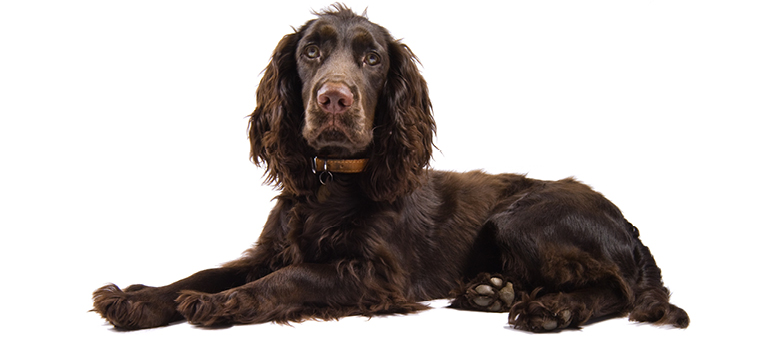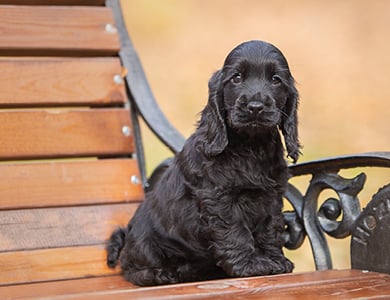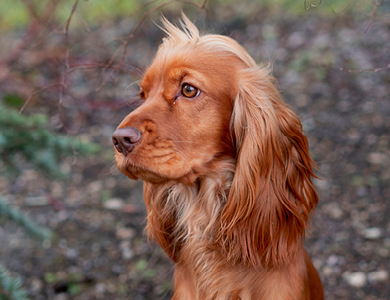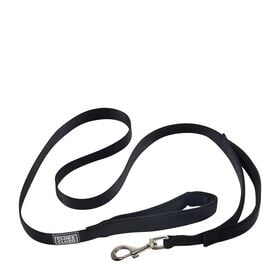John F. Kennedy, Richard Nixon, Oprah Winfrey, Charlize Theron, and Prince William and Kate Middleton have all been charmed by the English cocker spaniel, and it’s easy to understand why. This member of the spaniel family will melt your heart, whether with its gentle gaze, affectionate side or cheerful disposition.
Physical appearance
The English cocker spaniel is sturdy, compact and well-balanced. It has a characteristic expression that makes the breed appear intelligent and alert. The ideal height at the withers is 38 to 43 cm (15 to 17 in.) and the desirable weight is 12 to 15 kg (26 to 34 lbs). The female is usually smaller than the male. The coat on its head is short, fine, flat or slightly wavy, and silky. It must be of average length, with enough of an undercoat to provide adequate protection. The English cocker spaniel should be well feathered, but not so profusely to hide its silhouette or hamper the animal when it is working. Its long ears are covered in long hair, set low and extend at least to the nose. The English cocker spaniel’s coat can be solid coloured or many different colours. In parti-coloured dogs, the colouring must be evenly distributed on the body. The various accepted colours are solid black, black and tan, blue, liver, red, orange and lemon. Parti-colours can have some areas of white, but all-white dogs are not accepted. Although the tail is generally docked in North America, more and more English cocker spaniels have natural tails.
Life expectancy and health
English cocker spaniels in the U.K. and North America generally have an average lifespan of 11 or 12 years, which is typical for pure breeds, but a bit shorter than most other breeds of similar size.
The most common health problems for English cocker spaniels are allergies, cataracts, deafness and benign tumours. They can also suffer from hip dysplasia, patellar luxation, canine dilated cardiomyopathy and heart murmurs.
Energy level and temperament
The English cocker spaniel is an active dog that needs daily exercise for its physical and mental well-being. It does well with activities such as long walks or hikes with its owner, or playing ball in the yard.
Maintenance and grooming
Most English cocker spaniels have a fairly profuse coat that requires regular care to stay shiny. It should be thoroughly brushed and combed at least once a week to remove the undercoat and dead hair. In addition, the English cocker spaniel should be trimmed every month or so around the feet, on the face, under the neck, on the underside of the ears and under the tail. A bath is required only occasionally, but it is important to clean the ears regularly to prevent infections. As with all breeds, nails should be trimmed every two to three weeks to prevent foot problems.
Origins
Developed in England to help hunters of feathered game, more specifically for woodcock hunting, the English cocker spaniel is a descendent of Spanish hunting dogs (the word “spaniel” deriving from “Spanish”). Early on, spaniels were divided into land spaniels and water spaniels. The size of the dogs and the type of hunting terrain led to the different breeds that are known today. Moreover, all dogs that weighed less than 11 kg (25 lbs) at adult age were considered cockers. In the 19th century, the rise of dog shows, along with Victorian England’s mania for classification, led to designating the various types of spaniels as official breeds. This included the English springer spaniel, field spaniel, English cocker spaniel, Sussex spaniel and all the other British spaniel breeds.
In the early 20th century, American dog fanciers developed a cocker spaniel that was more of a pet than a hunting dog. It was smaller, with a more profuse coat, a shorter head and a more domed skull than its English cousin. In 1946, the American Kennel Club officially recognized the American cocker spaniel and the English cocker spaniel as separate breeds.

For more information, contact a registered breeder at the Canadian Kennel Club, who can answer all your questions. You can also contact the organization for information on breeders and the various breed clubs in Quebec and elsewhere in Canada.






